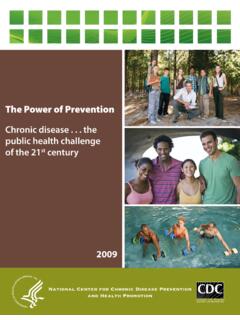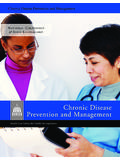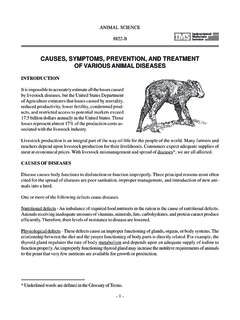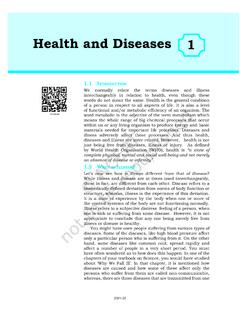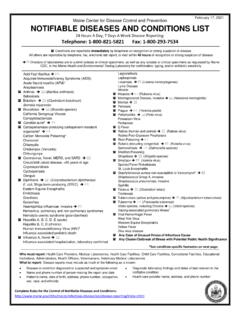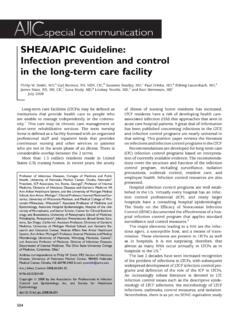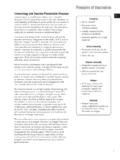Transcription of Preventing CHRONIC DISEASES a vital investment
1 PreventingCHRONIC DISEASESa vital investmentWHO Library Cataloguing-in-Publication DataWorld Health CHRONIC DISEASES : a vital investment : WHO global disease therapy medicine policy cooperation 92 4 156300 1 (NLM classifi cation: WT 500) World Health Organization 2005 All rights reserved. Publications of the World Health Organization can be obtained from WHO Press, World Health Organization, 20 Avenue Appia, CH-1211 Geneva 27, Switzerland (tel: +41 22 791 2476; fax: +41 22 791 4857; email: Requests for permission to reproduce or translate WHO publications whether for sale or for noncommercial distribution should be addressed to WHO Press, at the above address (fax: +41 22 791 4806.))
2 Email: The designations employed and the presentation of the material in this publication do not imply the expression of any opinion whatsoever on the part of the World Health Organization concerning the legal status of any country, territory, city or area or of its authorities, or concerning the delimitation of its frontiers or boundaries. Dotted lines on maps represent approximate border lines for which there may not yet be full mention of specifi c companies or of certain manufacturers products does not imply that they are endorsed or recommended by the World Health Organization in preference to others of a similar nature that are not mentioned.
3 Errors and omissions excepted, the names of proprietary products are distinguished by initial capital reasonable precautions have been taken by the World Health Organization to verify the information contained in this publication. However, the published material is being distributed without warranty of any kind, either express or implied. The responsibility for the interpretation and use of the material lies with the reader. In no event shall the World Health Organization be liable for damages arising from its use. This report was produced under the overall direction of Catherine Le Gal s-Camus (Assistant Director-General, Noncommunicable DISEASES and Mental Health), Robert Beaglehole (Editor-in-Chief) and JoAnne Epping-Jordan (Managing Editor).
4 The core contributors were Dele Abegunde, Robert Beaglehole, St fanie Durivage, JoAnne Epping-Jordan, Colin Mathers, Bakuti Shengelia, Kate Strong, Colin Tukuitonga and Nigel was offered throughout the production of the report by an Advisory Group: Catherine Le Gal s-Camus, Andres de Francisco, Stephen Matlin, Jane McElligott, Christine McNab, Isabel Mortara, Margaret Peden, Thomson Prentice, Laura Sminkey, Ian Smith, Nigel Unwin and Janet Vo xternal exper t review was provided by: Olusoji Adeyi, Julien Bogousslavsky, Debbie Bradshaw, Jonathan Betz Brown, Rober t Bur ton, Catherine Coleman, Ronald Dahl, Michael Engelgau, Majid Ezzati, Valentin Fuster, Pablo Gottret, Kei Kawabata, Steven Leeder, Pierre Lef bvre, Karen Lock, James Mann, Mario Maranh o, Stephen Matlin, Martin McKee, Isabel Mortara, Thomas Pearson, Maryse Pierre-Louis, G.
5 N. V. Ramana, Anthony Rodgers, In s Salas, George Schieber, Linda Siminerio, Colin Sindall, Krisela Steyn, Boyd Swinburn, Michael Thiede, Theo Vos, Janet Vo te, Derek Yach and Ping input, help and advice were received from policy advisers to the Director-General and many technical staff at WHO Geneva, regional directors and members of their staff, WHO country representatives and country offi ce were received from the following WHO regional and country offi ce staff: Mohamed Amri, Alberto Barc lo, Robert Burton, Luis Gerardo Castellanos, Lucimar Coser-Cannon, Niklas Danielsson, Jill Farrington, Antonio Filip Jr, Gauden Galea, Josefa Ippolito-Shepherd, Oussama Khatib, Jerzy Leowski, Silvana Luciani, Gudjon Magn sson, Sylvia Robles, Aushra Shatchkute, Marc Suhrcke, Cristobal Tunon, Cherian Varghese and Yanwei development and production were coordinated by Robert Beaglehole, JoAnne Epping-Jordan, St fanie Durivage, Amanda Marlin, Karen McCaffrey, Alexandra Munro, Caroline Savitzky, Kristin Thompson.
6 With the administrative and secretarial support of Elmira Adenova, Virgie Largado-Ferri and Rachel report was edited by Leo Vita-Finzi. Translation coordination was provided by Peter McCarey. The web site and other electronic media were organized by Elmira Adenova, Catherine Needham and Andy Pattison. Proofreading was by Barbara Campanini. The index was prepared by Kathleen Lyle. Distribution was organized by Maryvonne : Reda SadkiLayout: Steve Ewart, Reda SadkiFigures: Steve Ewart, Christophe Grangier Photography: Chris De Bode, Panos Pictures, United KingdomPrinting coordination: Robert Constandse, Rapha l Crettaz Printed in SwitzerlandMore information about this publication and about CHRONIC disease prevention and control can be obtained from:Department of CHRONIC DISEASES and Health PromotionWorld Health Organization CH-1211 Geneva 27, SwitzerlandE-mail: site.
7 Production of this publication was made possible through the generous fi nancial support of the Government of Canada, the Government of Norway and the Government of the United viLEE Jong-wook, Director-General, World Health Organization viSUPPORTING STATEMENTS viiiOlusegun OBASANJO, President, Federal Republic of Nigeria viiiAnbumani RAMADOSS, Minister of Health & Family Welfare, Government of India xWANG Longde, Vice-Minister of Health, the People s Republic of China xiiWHAT S INSIDE xivPART ONE OVERVIEW 1 PART TWO THE URGENT NEED FOR ACTION 32 Chapter 1 CHRONIC DISEASES : causes and health impacts 34 What are CHRONIC DISEASES ?
8 35 CHRONIC disease profi les 37 The causes of CHRONIC DISEASES 48 Risk factor projections 54 Projections of future deaths 57 A vision for the future: reducing deaths and improving lives 58 Chapter 2 CHRONIC DISEASES and poverty 61 From poverty to CHRONIC DISEASES 62 From CHRONIC DISEASES to poverty 66 CHRONIC DISEASES and the Millennium Development Goals 70 Chapter 3 The economic impact of CHRONIC DISEASES 74 Measuring the costs of CHRONIC DISEASES 75 Cost of illness studies 75 Macroeconomic consequences of CHRONIC DISEASES 77 The full costs of CHRONIC DISEASES for countries 82 Economic impact of achieving the global goal in countries 83ivPART THREE WHAT WORKS.
9 THE EVIDENCE FOR ACTION 88 Chapter 1 A strategy to achieve rapid results 90 Chapter 2 Review of effective interventions 96 Laws and regulations 96 Tax and price interventions 98 Improving the built environment 99 Advocacy 99 Community-based interventions 100 School-based interventions 100 Workplace interventions 102 Screening 103 Clinical prevention 104 disease management 109 Rehabilitation 112 Palliative care 113 PART FOUR TAKING ACTION.
10 ESSENTIAL STEPS FOR SUCCESS 120 Chapter 1 Providing a unifying framework the role of government 122 Introduction to the stepwise framework 124 Planning step 1 Estimate population need and advocate for action 126 Planning step 2 Formulate and adopt policy 128 Planning step 3 Identify policy implementation steps 132 Chapter 2 The private sector, civil society and international organizations 148 Partnerships 149 Networks 150 The private sector 151 Civil society 158 International organizations 159 ANNEXES 162 Annex 1 Methods for projections of mortality and burden of disease to 2015 163 Annex 2 WHO regions 166 Annex 3 World Bank income groupings 168 Annex 4 Economic analysis methods 170 Annex 5 The WHO-CHOICE method 172










